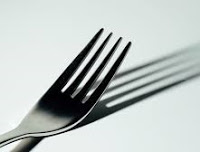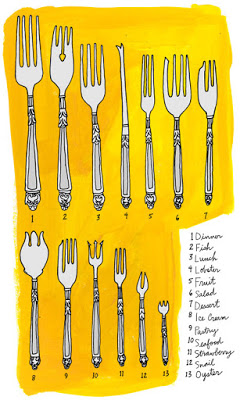Let’s talk about forks!
There’s a deli fork, table fork, fish fork, fruit fork, salad fork, ice cream fork, a dessert fork, and spaghetti fork. Whether they come in three of four teeth, it helps when we have them on the table every time we eat.
Some people start at the outside of the plate and work inward. Or snitch a glimpse at their host for guidance. Yet if you’re the one setting the table, well, you decide on your own. Most five-piece flatware sets come with two all-purpose forks. But those who entertain frequently keep a collection of shapes and sizes in their cutlery chests.
One rule of thumb: In order of use, forks go are always to the left of the dinner plate, except for the oyster fork.
Before these fancy forks that we have now, let’s look back at where the first fork used and who has invented it.
In ancient Egypt, Greece, and Rome, forks were initially used but not in the table for eating. Instead, they were lengthy cooking tools used for carving or lifting meats from a cauldron or from the fire. In the past, diners only ate with fingers and a knife. The smaller versions of forks were used in dining, which started in the noble courts of the Middle East and the Byzantine Empire in the 7th century. Later, it became common among wealthy families of the regions by the 10th century. (click here for more details)
Among other utensils, it had quite a scandalous story. In 1004, the Byzantine emperor’s niece married a doge’s son, and on the feast of the wedding, a golden fork was used. At that time, Europeans were still using their fingers when eating, and the local clergy saw the use of the golden forks as immoral. One Venetian uttered, “God has in His wisdom has provided man with natural forks—his fingers,” implying that it was an insult to God to substitute artificial metal forks when eating. A few years later, the bride died of the plague, and Saint Peter Damian preached that it was God’s punishment for her hateful vanity. (click here for more details)
Due to the decadence, forks in the Western world continued to carry the negative stigma. The arrival of the fork in central Europe was given tribute to the two Byzantine princesses who were married to European aristocrats, Empress Theophanu, who married Saxton Emperor Otto II in 972; and Dogaressa Teodora Anna Dukaina Selvo who married Venetian nobleman Domenico Selvo in 1075.
However, not until the next 300 years several royal courts across Europe held a small contingent of extravagantly designed forks for particular purposes and exotic meals.
However, the marriage of French King Henry II and Italian noblewoman Catherine de’ Medici paved the way to the popularity of fork in central Europe. The tradition of Italian noblewoman of eating with forks became very popular in entire France. On the other hand, most of Europe embraced the fork only by the 18th century and the United States only after the end of the American Revolution and early 19th century.
At the beginning of the 17th century, forks were still uncommon in the American colonies. They even had the difficulty using the utensil to spear food, and they had to use their spoons to steady the food while cutting with the right hand.
The mass production and the invention of the electroplating process made silver forks affordable in the 19th century. The rising middle class was given a chance to outdo the nobility and eat with forks made for specific foods, such as berries, lettuce, cake, meat, cucumbers, fish, ice cream, etc. However, materials used for fork handles were only organic such as bone, mother-of-pearl, and ivory. Fork tines were shortened and closer together, and remain so today. No longer did fingers touch food, except to pick up small fruit, such as grapes. Nor did servants wash forks during a meal for use with another course. (click here for more details)
Today, depending on occasion, style, and need, a set of flatware may contain five forks: dinner fork, fish fork, luncheon fork, salad or dessert fork, and seafood fork. But the collector may keep specialized forks from antique shops and specialty stores, for eating lobster, fruit, dessert, ice cream, pastry, strawberries, snails, and oysters.


